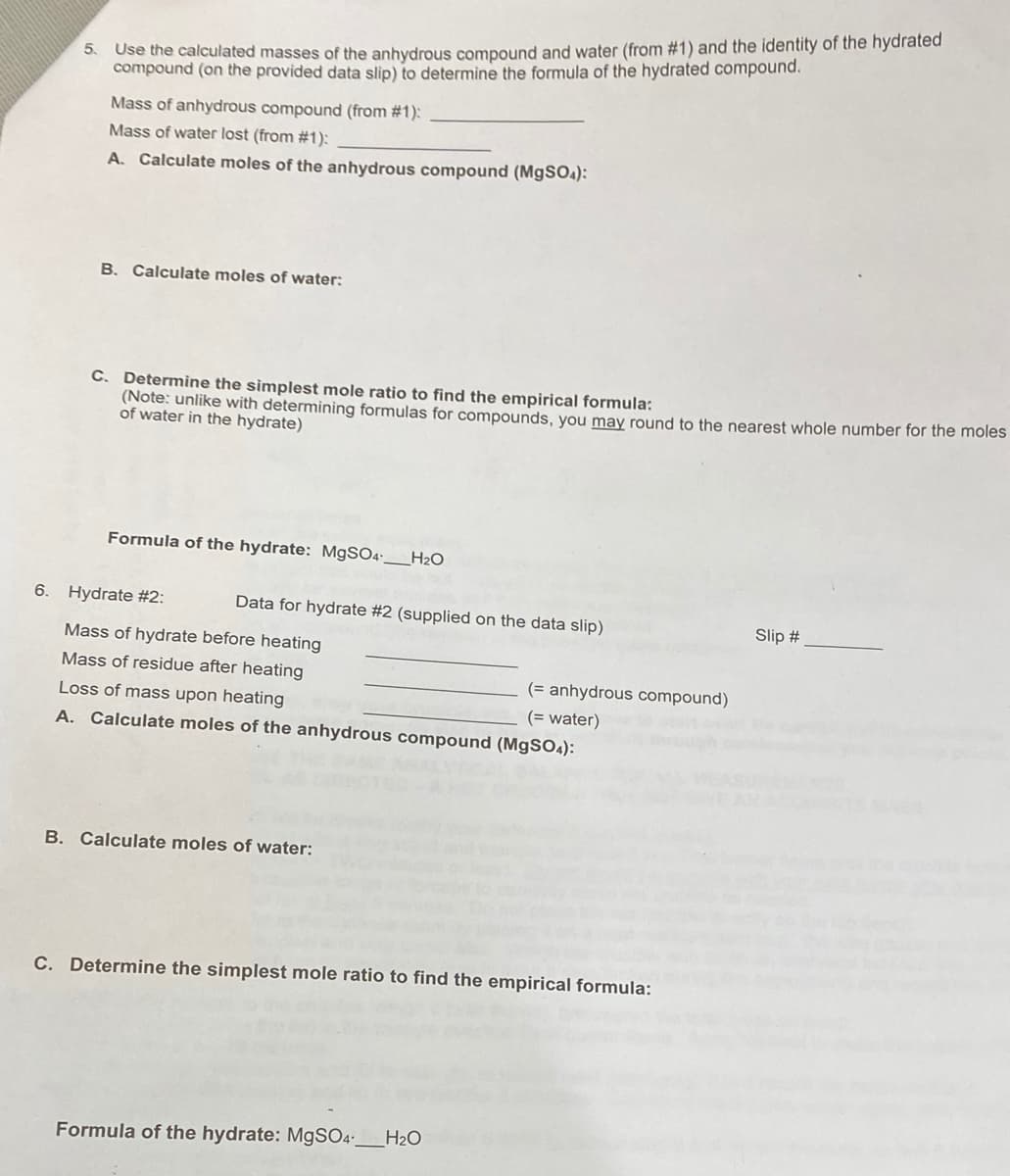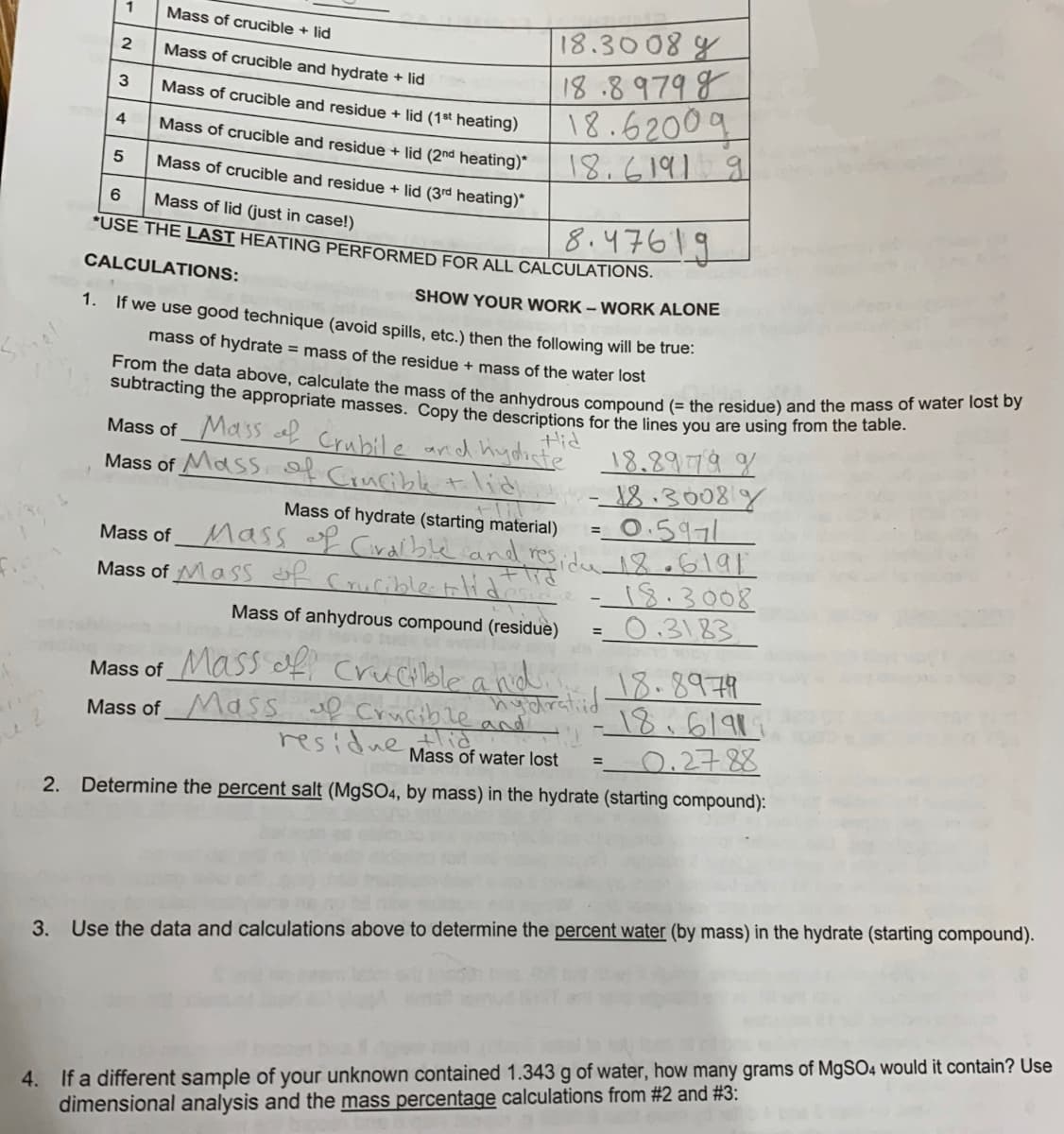Mass of crucible + lid 18.30 08 Y 18.8979g 18.62009 |8.८1१। १ From the data above, calculate the mass of the anhydrous compound (= the residue) and the mass of water lost by Mass of crucible and hydrate + lid 3 Mass of crucible and residue + lid (1st heating) Mass of crucible and residue + lid (2nd heating)" Mass of crucible and residue + lid (3rd heating)" Mass of lid (just in case!) 8.47619 "USE THE LAST HEATING PERFORMED FOR ALL CALCULATIONS. CALCULATIONS: SHOW YOUR WORK – WORK ALONE 1. If we use good technique (avoid spills, etc.) then the following will be true. mass of hydrate = mass of the residue + mass of the water lost subtracting the appropriate masses. Copy the descriptions for the lines you are using from the tabio. Mass ofMa ss af Crubile and hydicte Mass of Mass of Ciucible tlid tid 18.8979% - 18.3008g 0.5971 Mass of hydrate (starting material) %3D Mass of MasS Ciralble and residee 18 o6191 Mass of Mass of Crucible trido 18.3008 0.3183 Mass of anhydrous compound (residue) Mass of Mass Crucible a nd Mass ofMa Ss uf Crucible and residueNd 18.8979 18.6191. 0.2788 Mass of water lost %3D 2. Determine the percent salt (M9SO4, by mass) in the hydrate (starting compound): 3. Use the data and calculations above to determine the percent water (by mass) in the hydrate (starting compound). If a different sample of your unknown contained 1.343 g of water, how many grams of MgSO4 would it contain? Use dimensional analysis and the mass percentage calculations from #2 and #3: 4.
Mass of crucible + lid 18.30 08 Y 18.8979g 18.62009 |8.८1१। १ From the data above, calculate the mass of the anhydrous compound (= the residue) and the mass of water lost by Mass of crucible and hydrate + lid 3 Mass of crucible and residue + lid (1st heating) Mass of crucible and residue + lid (2nd heating)" Mass of crucible and residue + lid (3rd heating)" Mass of lid (just in case!) 8.47619 "USE THE LAST HEATING PERFORMED FOR ALL CALCULATIONS. CALCULATIONS: SHOW YOUR WORK – WORK ALONE 1. If we use good technique (avoid spills, etc.) then the following will be true. mass of hydrate = mass of the residue + mass of the water lost subtracting the appropriate masses. Copy the descriptions for the lines you are using from the tabio. Mass ofMa ss af Crubile and hydicte Mass of Mass of Ciucible tlid tid 18.8979% - 18.3008g 0.5971 Mass of hydrate (starting material) %3D Mass of MasS Ciralble and residee 18 o6191 Mass of Mass of Crucible trido 18.3008 0.3183 Mass of anhydrous compound (residue) Mass of Mass Crucible a nd Mass ofMa Ss uf Crucible and residueNd 18.8979 18.6191. 0.2788 Mass of water lost %3D 2. Determine the percent salt (M9SO4, by mass) in the hydrate (starting compound): 3. Use the data and calculations above to determine the percent water (by mass) in the hydrate (starting compound). If a different sample of your unknown contained 1.343 g of water, how many grams of MgSO4 would it contain? Use dimensional analysis and the mass percentage calculations from #2 and #3: 4.
Principles of Instrumental Analysis
7th Edition
ISBN:9781305577213
Author:Douglas A. Skoog, F. James Holler, Stanley R. Crouch
Publisher:Douglas A. Skoog, F. James Holler, Stanley R. Crouch
Chapter33: Automated Methods Of Analysis
Section: Chapter Questions
Problem 33.8QAP
Related questions
Question

Transcribed Image Text:Use the calculated masses of the anhydrous compound and water (from #1) and the identity of the hydrated
compound (on the provided data slip) to determine the formula of the hydrated compound.
5.
Mass of anhydrous compound (from #1):
Mass of water lost (from #1):
A. Calculate moles of the anhydrous compound (MgSO.):
B. Calculate moles of water:
C. Determine the simplest mole ratio to find the empirical formula:
(Note: unlike with determining formulas for compounds, you may round to the nearest whole number for the moles
of water in the hydrate)
Formula of the hydrate: M9SO4• _H2O
6. Hydrate #2:
Data for hydrate #2 (supplied on the data slip)
Slip #
Mass of hydrate before heating
Mass of residue after heating
(= anhydrous compound)
Loss of mass upon heating
(= water)
A. Calculate moles of the anhydrous compound (M9SOA):
B. Calculate moles of water:
C. Determine the simplest mole ratio to find the empirical formula:
Formula of the hydrate: MgSO4:-
_H2O

Transcribed Image Text:From the data above, calculate the mass of the anhydrous compound (= the residue) and the mass of water lost by
subtracting the appropriate masses. Copy the descriptions for the lines you are using from the table.
1
Mass of crucible + lid
18.30 08 Y
18.8979g
18.62009
18.6191
Mass of crucible and hydrate + lid
3
Mass of crucible and residue + lid (1st heating)
4
Mass of crucible and residue + lid (2nd heating)"
Mass of crucible and residue + lid (3rd heating)"
Mass of lid (just in case!)
8.47619
*USE THE LAST HEATING PERFORMED FOR ALL CALCULATIONS.
CALCULATIONS:
SHOW YOUR WORK – WORK ALONE
1.
If we use good technique (avoid spills, etc.) then the following will be true:
mass of hydrate = mass of the residue + mass of the water lost
Smel
Mass of Ma ss f Crubile and hydicte
Mass of Mass of Cincible tlid
tid
18.8979%
18.30088
0.5971
Mass of hydrate (starting material)
%3D
Mass of Cvalble and res,ide o6191
Mass of
Flid
Mass of Mass of Crucible tilid
18.3008
0.3183
Mass of anhydrous compound (residue)
%3D
Mass of Mass crucible a nid
फनुननडो
Q Crucib le and
18.8979
18.6191
0.2788
Mass of Ma SS
residue
Mass of water lost
%3D
2. Determine the percent salt (MgSO4, by mass) in the hydrate (starting compound):
3.
Use the data and calculations above to determine the percent water (by mass) in the hydrate (starting compound).
4. If a different sample of your unknown contained 1.343 g of water, how many grams of M9SO4 would it contain? Use
dimensional analysis and the mass percentage calculations from #2 and #3:
Expert Solution
This question has been solved!
Explore an expertly crafted, step-by-step solution for a thorough understanding of key concepts.
This is a popular solution!
Trending now
This is a popular solution!
Step by step
Solved in 4 steps

Recommended textbooks for you

Principles of Instrumental Analysis
Chemistry
ISBN:
9781305577213
Author:
Douglas A. Skoog, F. James Holler, Stanley R. Crouch
Publisher:
Cengage Learning

EBK A SMALL SCALE APPROACH TO ORGANIC L
Chemistry
ISBN:
9781305446021
Author:
Lampman
Publisher:
CENGAGE LEARNING - CONSIGNMENT

Organic Chemistry: A Guided Inquiry
Chemistry
ISBN:
9780618974122
Author:
Andrei Straumanis
Publisher:
Cengage Learning

Principles of Instrumental Analysis
Chemistry
ISBN:
9781305577213
Author:
Douglas A. Skoog, F. James Holler, Stanley R. Crouch
Publisher:
Cengage Learning

EBK A SMALL SCALE APPROACH TO ORGANIC L
Chemistry
ISBN:
9781305446021
Author:
Lampman
Publisher:
CENGAGE LEARNING - CONSIGNMENT

Organic Chemistry: A Guided Inquiry
Chemistry
ISBN:
9780618974122
Author:
Andrei Straumanis
Publisher:
Cengage Learning